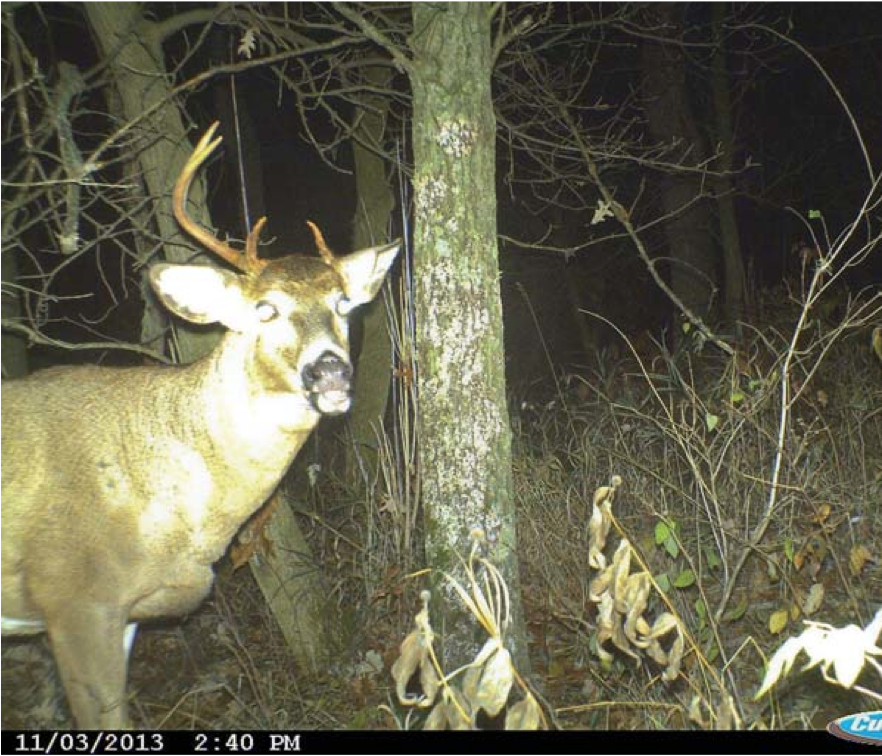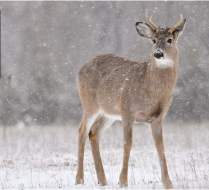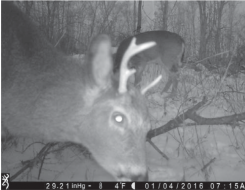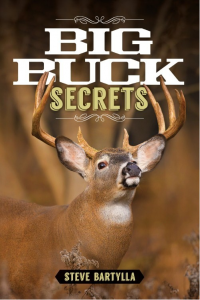White-tailed deer tend to grow antlers that are fairly well-balanced. That is, one side looks pretty much like the other. Keep in mind, however, that no two antlers are ever exactly alike, although their similarities from side to side, or even from one buck to the next, are sometimes striking. 
Nevertheless, deer antlers are exceedingly complicated structures and may take many forms — sometimes bizarre in nature.
Scientists generally agree that side-to-side irregularities in antler form might result from hormone imbalances, gonadal damage, poor nutrition, skeletal injuries, or damage to the pedicle or growing antler.
Genetic effects more likely affect both sides. However, it’s difficult to determine which traits are of genetic origin and which are not. Therefore, selective harvesting (i.e., culling) of bucks with inferior antlers, especially on one side, to improve antler quality becomes a debatable strategy.
A relatively common antler abnormality observed in members of the deer family, whitetails included, is referred to as spike-on-one-side. Many believe that bucks with a spike antler on one side, but a normal branched antler on the other, possess inferior genetics for antler growth. This assumption has fueled the notion that these bucks should be removed from the population.
Based on prior observations, Auburn University researchers Gabriel Karns and Steve Ditchkoff hypothesized that the spike-on-one-side antler phenomenon resulted from damage to the skull and/or antler pedicle — not heredity traits. Hence, they question the merits or procedures involved in buck culling strategies designed to minimize the occurrence of such abnormalities.
THE STUDY To test their theory, the Auburn researchers collected 71 sets of antlers showing the spike-on-one-side phenomenon from hunter-harvested bucks in Alabama during two hunting seasons (2010-11 and 2011-12).
Once the antlers and skull materials were cleaned, the researchers estimated deer age, recorded the number of typical antler points per side and categorized any damage to the skull, pedicle or antler. Hunters provided additional information relative to date and location of harvest, as well as any other visual signs of bodily trauma such as old gunshot wounds or broken bones.
 Probable cause of spike-on-one-side antler formation could be determined for 43 antler sets. In other words, contributing factors for nearly 40 percent of the collected specimens were undetermined and were likely caused by other factors than direct injury to the pedicle or surrounding area of the skull.
Probable cause of spike-on-one-side antler formation could be determined for 43 antler sets. In other words, contributing factors for nearly 40 percent of the collected specimens were undetermined and were likely caused by other factors than direct injury to the pedicle or surrounding area of the skull.
Interestingly, young bucks were less likely than older bucks to exhibit symptoms of pedicle or skull damage. Three of 10 (30 percent) yearling buck antler sets had sustained breakage of the hardened antler, but none had pedicle or skull damage.
Nine of 20 (45 percent) 21⁄2-year- old bucks exhibited some form of pedicle, skull or antler malady contributing to their spike-on-one- side antler development. Two of them had skull and/or pedicle damage and malformed pedicles. One had breakage of the hard antler and another sustained injury to velvet antlers. Two others had similar damage that had subsequently healed. One had an abscess close to a pedicle, probably causing abnormal antler growth, while two bucks each had one abnormally small pedicle.
Spike-on-one-side inducing abnormalities were detected in 31 of 41 (76 percent) 31⁄2-year-old bucks. The most common cause noted was some form of skull damage and resultant pedicle malformation (14 individuals). Seven others sustained skull damage not affecting pedicle formation, while five had malformed pedicles but no apparent skull injury. Five bucks suffered miscellaneous problems, such as improper pedicle position, missing skull bones, accessory pedicles and “double-headed” antlers.
Karns and Ditchkoff concluded that pedicle and/or skull damage was the primary cause of the spike-on- one-side phenomenon and that the frequency of such abnormal growth increased with a buck’s age. Furthermore, given the buck age relationship, they suggested that most such damage is probably due to fighting and rubbing trees prior to and during the breeding season. “Logically,” they emphasized, “the more antler-growth cycles a white-tailed deer undergoes the greater the probability of sustaining significant damage to the skull or pedicle.”
The authors acknowledged that pedicle damage can take many forms.
For example, they said, “There is evidence that cast antlers with a residual portion of pedicle and/or skull material [referred to as dirty sheds] have a high probability of developing spike-on-one-side antler characteristics in subsequent years, and that males already possessing spike-on-one-side antler traits commonly cast antlers with fractured pedicles.”
 This study could not identify probable cause for spike-on-one-side in a large percentage of young animals. For example, other than three instances of antler breakage, they could not ascribe probable cause to any other yearlings, nor could they explain such abnormal antlers for more than one-half of the 2 1⁄2-year-old specimens.
This study could not identify probable cause for spike-on-one-side in a large percentage of young animals. For example, other than three instances of antler breakage, they could not ascribe probable cause to any other yearlings, nor could they explain such abnormal antlers for more than one-half of the 2 1⁄2-year-old specimens.
Given findings from other studies, it’s highly likely that at least some of these could have been attributed to gunshot wounds, skeletal injury or gonadal trauma had an entire carcass examination been performed. Even skull and/or pedicle injuries might have been linked to aspects of an animal’s physiology, such as variations in bone density and antler mineralization. However, those factors were not investigated.
Research evidence also indicates that at least some antler abnormalities due to skeletal injury have a good chance of returning to normal in subsequent years. In contrast, abnormal antlers due to pedicle or skull injury often re-aggravate and tend to get progressively worse in future years because of repeated injury.
CONCLUSIONS Most one-sided antler abnormalities, such as spike-on-one-side, are likely the result of some form of physical injury, either to the skull and/or pedicle or some other part of the body. They tend to be most prevalent among mature bucks due to fighting and tree rubbing. In contrast, the normal side is more indicative of the buck’s true geneotypic antler make-up.
Based on their findings, Karns and Dichkoff recommend the following: “Yearling bucks should not be culled because of abnormal antler development for management purposes, because immature male white-tailed deer are likely to develop normal antlers in the future.”
In addition, where herd numbers are well below carrying capacity and mature males are in short supply, they suggested “preserving mature males regardless of antler configuration to benefit herd health through stabilization of the breeding season.”
— John Ozoga has been D&DH’s top research contributor for more than 20 years. He is a retired deer research biologist.
LITERATURE CITED Karns, G. R. and S. E. Ditchkoff. 2013. “Trauma-induced Malformed Antler Development in Male White-tailed Deer. Wildlife Society Bulletin 37:832-837.
+++++
Learn How to Kill Big Bucks  Solidly grounded in Bartylla’s wealth of experience, this buck hunting guide seeks to help real-world hunters take their craft to the next level. Chapters in his super book “Big Buck Secrets” include comprehensive instruction on everything from scouting new hunting areas to calling strategies, hunting during the rut, understanding mature buck behavior, aggressive and creative techniques, and more. Get your copy today!
Solidly grounded in Bartylla’s wealth of experience, this buck hunting guide seeks to help real-world hunters take their craft to the next level. Chapters in his super book “Big Buck Secrets” include comprehensive instruction on everything from scouting new hunting areas to calling strategies, hunting during the rut, understanding mature buck behavior, aggressive and creative techniques, and more. Get your copy today!











































